Vinyl Record Storage and Care
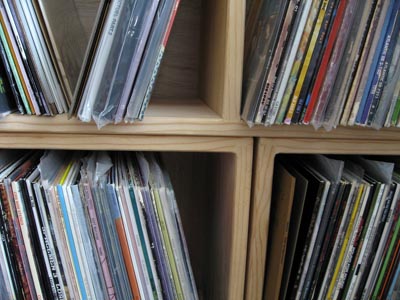 Vinyl records are expensive, and they take up a lot of space. It’s also rather unusual for a buyer of vinyl records to purchase only one. If you’re a buyer of records, chances are that sooner or later, you’re going to end up owning a lot of them.
Vinyl records are expensive, and they take up a lot of space. It’s also rather unusual for a buyer of vinyl records to purchase only one. If you’re a buyer of records, chances are that sooner or later, you’re going to end up owning a lot of them.
We’re not going to complain; after all, we like records, and we have a lot of them around here. That said, when you take on the responsibility of investing money in a collection of record albums, you’re going to have to deal with the issues of vinyl record storage and care. In order to protect your investment, you’re going to have to devote some time, money, and space to storing your records and ensuring that they’re clean and well cared for.
In this article, we’ll cover some of the issues associated with vinyl record storage and care, and suggest a few accessories which can help you get the most out of your collection of vinyl records.
Browse by Category
Click any of the links below to jump to each category:
Vinyl Record Storage Requirements
Record Storage Solutions
Do It Yourself
General Purpose Shelving
Vinyl Record Storage Crates
Dedicated Vinyl Record Storage Shelves
Protection for Your Records
Keeping Your Records Clean
Protective Vinyl Record Sleeves
Record Cleaning Machines
Conclusion
Vinyl Record Storage Requirements
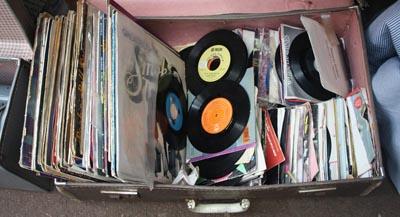 If you own just a single record album, chances are you’ve just laid it down on a table or a shelf somewhere. Once you have purchased a second one, however, you’ll start to run into the problem of vinyl record storage. As your collection gets larger, you’re going to have to find a solution for vinyl record storage that meets the following criteria:
If you own just a single record album, chances are you’ve just laid it down on a table or a shelf somewhere. Once you have purchased a second one, however, you’ll start to run into the problem of vinyl record storage. As your collection gets larger, you’re going to have to find a solution for vinyl record storage that meets the following criteria:
- Keeps the rest of your home tidy
- Stores your records safely
- Makes individual albums easy to find
Obviously, a stack of albums, or worse, multiple stacks of albums, does not work well with anyone’s lifestyle. While stacking your albums vertically seems to be the default solution for newbies, you’ll quickly find that it’s a poor solution for vinyl record storage.
Why?
A stack of records is unwieldy; it can only get so large before it’s likely to fall over. We’ll admit that we were once in a home that had albums stacked vertically all the way to the ceiling, but we’ll also admit that that particular home had records stacked to the ceiling in every single room and that not a single album (or room!) was accessible for anyone who wanted to play one.
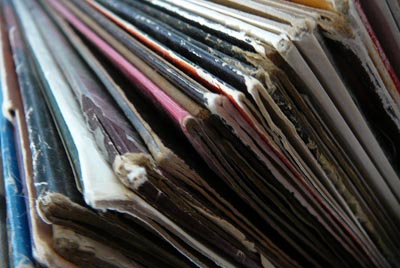 Vertically stacked records are cumbersome and dangerous, as the stack, if it becomes tall enough, can fall over and damage other items in the room or even hurt people. Furthermore, records stacked vertically are difficult to sort.
Vertically stacked records are cumbersome and dangerous, as the stack, if it becomes tall enough, can fall over and damage other items in the room or even hurt people. Furthermore, records stacked vertically are difficult to sort.
What if you have a stack of one hundred albums and the one you want to play is in the middle? You’ll have to move some of the albums on top to a separate pile, creating a second stack and taking up a lot more room.
A further problem with vertically stacked records is that piling them up that way is not good for either the record or the cover. Long-play albums aren’t actually flat; they’re thicker near the label and thinner near the edge. If you store them in vertical stacks, even with the covers on, the records are more likely to warp. In addition, the covers are more likely to encounter wear, particularly near the center of the cover, which is where the album is thickest.
No, stacking your albums vertically is a poor form of vinyl record storage. What you should do instead is turn the stack sideways and place them on a shelf or in a container in such a way that the albums are stored on their bottom edge, with the spine of the cover facing towards you.
That makes it easy to see the name of the album’s artist and the album title. If you sort your albums alphabetically (or in any other order that makes sense to you), you will find that it’s easy to find any particular album at any given time if they’re stored this way.
While this is the ideal form of vinyl record storage, records do take up a lot of space. They also weigh quite a bit, and if you own more than a few hundred albums, you’re going to want a form of vinyl record storage that includes multiple shelves, or at least the ability to have some albums stored above others. This will minimize the “footprint” of your vinyl record storage and keep you from having albums all over your house.
Record Storage Solutions
There are any one of a number of solutions for this type of vinyl record storage, including do it yourself (DIY) shelving, storage crates and boxes, stackable cube storage devices, general purpose shelving originally intended for some other use, and dedicated vinyl record storage shelving products.
Here we’ll list a few suggestions regarding each type of vinyl record storage:
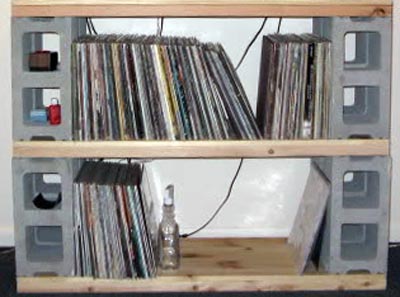 While the DIY solution for vinyl record storage may not be the most elegant or the prettiest possible answer to the problem, this tried-and-true shelving system offers a low-cost solution that’s surprisingly sturdy.
While the DIY solution for vinyl record storage may not be the most elegant or the prettiest possible answer to the problem, this tried-and-true shelving system offers a low-cost solution that’s surprisingly sturdy.
All you’ll need is a number of cinder blocks and some sturdy lumber. Your average cinder block measures 16”x8”x8”, so if you stand them up vertically with two next to on another, you’l be able to build shelving that’s 16” high and deep, which is more than tall enough and wide enough for record albums. While most suggestions for this type of shelving involve using wood for the shelving, we’ve found that using an interior door makes for a sturdier shelf.
You can purchase these doors new at home improvement stores and you can likely find them second hand if you shop around. Using a piece of wood can cause your shelf to sag. If you’re using shelving that’s longer than five feet or so, you’ll likely want to put additional cinder blocks in the middle.
Cinder blocks are quite strong, and if you use shelving that’s sufficiently sturdy, you should be able to build shelving that’s several shelves high. This should provide vinyl record storage for all but the largest of collections.
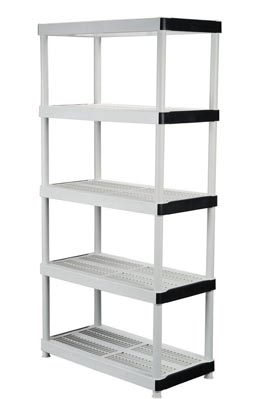 If you shop at any large department store, you can find general purpose shelving of all types and sizes. While many of these shelving systems are quite affordable, the problem is that none of them have been specifically designed for vinyl record storage. This can be a problem, though it’s not necessarily one that cannot be overcome.
If you shop at any large department store, you can find general purpose shelving of all types and sizes. While many of these shelving systems are quite affordable, the problem is that none of them have been specifically designed for vinyl record storage. This can be a problem, though it’s not necessarily one that cannot be overcome.
First of all, make sure that the shelving is strong enough to support the records you intend to store within it. Albums can weigh a lot, and 100 albums can cause inexpensive metal shelving to fold like a house of cards.
Assuming that your shelving is sturdy enough, you’ll also have to ensure that the sides of the shelving will support having records leaning against them. Many inexpensive shelving solutions have openings on the ends (see image) that can make them poorly suited to vinyl record storage. This can often be resolved by cutting a piece of plywood that’s larger than the opening on each shelf and using it to cover the opening. You can then lean your records against the plywood.
The tradeoff with general purpose shelving is that while it’s not designed specifically for storing records, it’s usually more affordable, especially for large shelves, than dedicated solutions.
Below are some examples of some general purpose shelving that will likely be suitable for vinyl record storage with some modification:
Edsal Black Steel Storage Rack
This unit measures 72″ tall and 48″ wide, and can hold up to 4000 pounds, which should be more than adequate for most collections. The shelves are adjustable, made from sturdy particleboard, and are supported by double riveted steel beams. The frame has a corrosion-free black finish.
Click here to learn more about this item at Amazon (opens in a new window)
Tournus Commercial Anodized Aluminum Shelving Unit
This unit measures nearly 36″ wide, and stands 69″ tall. It’s made from heavy duty aluminum and has four adjustable shelves. You can assemble it without tools. Each shelf is capable of holding more than 300 pounds, which is more than enough to handle even huge collections.
They’re great if you like the utilitarian look, rather than something that looks like furniture.
Click here to learn more about this item at Amazon (opens in a new window)
Non-Stackable Record Crates
If you just have a few record albums (less than 100 or so), you can probably make use of a non-stackable vinyl record storage crate. Most are easy to move, and if your collection grows, you can buy more than one.
Here are a few examples:
Atlantic Record Crate Shelf
The Atlantic Record Crate Shelf has a natural wood look, and features a pair of handles for easily moving it around. The end features a classic 45 RPM adapter graphic, making it obvious that this convenient design was intended specifically for vinyl record storage. It should hold up to 50 albums easily, measuring 12.5x14x13.5 inches.
Click here to learn more about this item at Amazon (opens in a new window)
AEC LP Record Crate
The AEC LP Record Crate, by Crate Farm, has that “classic” record crate look; back in the 1970s, all record storage crates looked a lot like this one. Measuring 24x14x14 inches, this sturdy wooden crate should easily hold 100 albums or more. Holes are pre-drilled for easy assembly, and instructions and all necessary hardware are included. If you want that classic vinyl record storage solution for your classic albums, this one is just the ticket.
Click here to learn more about this item at Amazon (opens in a new window)
Stackable Vinyl Record Storage
A number of companies make small wooden storage crates for record albums. These are standalone devices intended to hold anywhere from 40 to 100 albums. Many of these crates have been built in such a way that they can be easily stacked, allowing you additional vinyl record storage without using up any more of your precious floor space. Stackable crates are the wise choice for anyone who thinks their collection might continue to grow over time.
Here are a few examples:
LP Record Storage Crate
The appropriately named “LP Record Storage Crate” by Poole and Sons measures 16x16x13 inches, and should hold approximately 75 record albums. It’s made from simple unfinished wood (looks like pine) and assembles in a couple of minutes using a screwdriver.
Click here to learn more about this item at Amazon (opens in a new window)
Foremost Modular Open Cube Storage System
The Foremost Modular Open Cube Storage System wasn’t specifically designed for vinyl record storage, but it works really well for it and no one will know. It works for books, DVDs or pretty much anything else, too. Made with a wood frame covered with PVC laminate, these cubes are sturdy, attractive, and quite affordable. They’re available in white, brown, espresso and black, for those who want a bit of variety.
The cubes measure 15x15x15 inches, and each one is capable of holding 200 pounds of records. They’re stackable, too, so they can accommodate your collection as it grows. Just buy more when you need them. This one’s a bargain.
Click here to learn more about this item at Amazon (opens in a new window)
Sefour LP Record Black Box
Similar to the Foremost system above, the Sefour LP Record Black Box is a stackable cube, though this one was expressly designed for vinyl record storage. Measuring 13.5×16.x13.5 inches, these sturdy boxes hold approximately 60 albums. They’re stackable, and they include a chrome carrying handle. As the name suggests, they’re only available in black.
Click here to learn more about this item at Amazon (opens in a new window)
Way Basics Stackable Vinyl Record Storage Cube
The Way Basics Stackable Vinyl Record Storage Cube is similar to the Foremost system, and like those, it’s available in four colors – natural, espresso, black, and white. Unlike the Foremost system, the Way Basics system was designed just for records.
The unit has easy assembly that requires no tools. The cubes, measuring 12.9×13.4×13.4 inches, are made from recycled paperboard. They’re stackable, and each one can support 50 pounds and should hold 60-75 albums.
Click here to learn more about this item at Amazon (opens in a new window)
Dedicated Vinyl Record Storage Shelves
If you’re serious about vinyl record storage, you should invest in some dedicated storage solutions. There are a number of companies that manufacture sturdy, heavy duty shelving systems that are ideal for securely storing record albums for both short term and long term use. Some are made especially for storing records, and others can double as a bookshelf. Regardless of intent, these are shelving systems, rather than boxes or crates.
Many of these systems are modular, giving you the opportunity to expand them as your collection grows. On the downside, some of these storage solutions, while rugged, are quite expensive and may be beyond the budget of many collectors.
Here are a few examples:
Ikea Kallax 4 Shelving Unit
The Ikea Kallax 4 Shelving Unit has that simple, elegant Ikea design that you either love or hate. Each unit is divided into four sub-units, providing additional support. The units measure 30 3/8×30 3/8×15 1/2 inches and are made from sturdy particleboard. The Kallax system is available in five colors – birch, pink, red, white, and black.
Each of the four sections should hold about 50 albums, giving you more than adequate storage for modest collections. If you need something larger, there are larger sizes in the Kallax line, including units that have eight units and a gigantic unit that has sixteen.
Click here to learn more about this item at Amazon (opens in a new window)
Ikea NORNÄS Sideboard
The NORNÄS is a relatively new line of shelving from Ikea, and these units come in basic, unfinished wood. You can stain them, paint them, or just leave them as they are. This unit has 8 sub-units, and metal legs, providing an extra-sturdy vinyl record storage solution.
These units, made from pine, measure 56 1/4″ wide by 34 5/8″ high by 15 3/4″ deep and should provide adequate storage for 400-500 albums.
Click here to learn more about this item at Amazon (opens in a new window)
Line Phono Turntable Station Turntable Stand
This unit, from Line Phono, can not only hold 200 albums, but it will also provide a sturdy shelf for your turntable. The interlocking shelves are made from high-grade medium density fiberboard, and includes individually adjustable feet.
Click here to learn more about this item at Amazon (opens in a new window)
DKVinylDisplays Customizable Vinyl Record Storage
This rustic but attractive unit, made by DKVinylDisplays, is custom-made to order by a company that specializes in artisanal vinyl storage solutions. These study units are crafted by hand from wood and look great. Other vinyl record storage units are available and your unit can be ready in 11-15 days. If you like the look of custom furniture and like the idea of having something built just for you, you’ll love this unit.
Click here to learn more about this item at Amazon (opens in a new window)
Sefour 500 LP Vinyl Storage Unit Tobacco Walnut
If you want something that’s attractive, useful, and space-saving, you’ll love the Sefour 500 LP Vinyl Storage Unit. Available in black or tobacco walnut, this beautiful unit can hold 300-500 records on its four sturdy shelves. The unit measures 56″ tall, 17 1/2″ wide and is 14 1/2″ deep at the top and 19 3/4″ deep at the bottom. The curved design gives you a wide base, which adds stability.
Click here to learn more about this item at Amazon (opens in a new window)
Protection for Your Records
Now that you’ve solved your problem with vinyl record storage, you need to consider the proper care for your record albums.
Your first consideration should be to care for the cover, as the paper and cardboard covers are subject to wear. This is a greater problem if your albums are either stacked or stored on a shelf, as the covers will rub against one another. Most covers are prone to wear in the middle near the record label, and around the edges of the record. This album cover wear usually presents itself in the form of a ring.
What about the factory shrink wrap? Most albums sold new in the United States are sealed at the factory in thin vinyl shrinkwrap, but shrinkwrap isn’t very good for protecting covers. If exposed to even modest heat, shrinkwrap can shrink even more than intended, potentially leading to warped records.
In addition, the shrinkwrap is rather thin and prone to tearing easily. Once it tears and falls off, it won’t offer any protection at all.
Even if you choose to keep the shrinkwrap on your records, for protection against dust or because the cover has a sticker on it that you’d like to preserve, your best solution for long term preservation of your album covers is to store your album isn a plastic sleeve. The album can be removed from the sleeve for play and returned to the sleeve for proper storage after you’re done listening to it.
Most outer album sleeves are 3-4 thousandths of an inch thick and are made from polyethylene plastic. This plastic works well for protecting album covers and most sleeves can accommodate both single and double albums.
Polyethylene can get cloudy over a period of several years, and because of this, some collectors prefer to use polypropylene sleeves. These sleeves have an additional advantage of being resealable; they have a folding flap that attaches to a mildly adhesive strip on the back of the sleeve. These sleeves offer extra protection by covering all four edges of your album covers.
You might want to use both types, using polyethyline bags for your more common items, and the more protective polypropylene bags for better vinyl record storage for your high ticket items.
Here are a few examples:
3 Mil Polyethylene Outer Sleeves – Pack of 100
These high quality outer sleeves are made from virgin polyethylene. Measuring 12 3/4″x12 1/2″, they should fit most single and double albums. They’re cut flush at the top, so the top of the sleeve should line up with the top of your album cover.
Click here to learn more about this item at Amazon (opens in a new window)
Resealable Polypropylene Outer Sleeves – Pack of 100
For something a bit more secure to protect your album covers, these outer sleeves are made from more durable polypropylene. They’re also resealable, as they have a folding flap that attaches to an adhesive strip on the back of the sleeve. These sleeves will fully enclose your valuable album covers.
Click here to learn more about this item at Amazon (opens in a new window)
Protective Vinyl Record Sleeves
Now that you’ve taken care of preventing album cover wear, you need to consider something more important – protecting the record itself.
With the exception of a few budget labels that operated in the 1960s, most record companies have placed their records in a paper (sometimes posterboard) inner sleeve prior to putting them in the cover. The paper sleeves offered some protection against wear, as a paper sleeve is less abrasive than the cardboard cover itself.
Paper sleeves are abrasive, however, and over time, removing the record from the sleeve and putting it back will cause some damage to the disc itself. While the wear won’t be as extreme as if you were rubbing the record with sandpaper, the effects over time are noticeable and eventually, you’ll hear them in the form of a scratchy-sounding, noisy record.
In addition, the edges of a record can often cause the sides of a paper sleeve to split. In some cases, the sleeves can tear in two. This is never a good thing, and it’s even worse if your album came with a custom sleeve or a sleeve containing song lyrics.
It would be nice if records were sold with plastic, non-abrasive sleeves, and a few, such as those sold as high-quality audiophile pressings, often are. For all of your other albums, however, it’s best to remove the record from the paper sleeve the first time you play it and never put it back in that paper sleeve again.
Instead, you should use a high-quality inner sleeve, either made from Japanese rice paper or HDPE (high density polyethylene). These sleeves have a smooth surface that not only offer better protection for your records than the paper sleeves that came with them, but their slick surface also allows you to remove and replace the records from the cover more easily.
Here are a few examples:
Anti-Static Round Bottom HDPE Inner Sleeves – Pack of 50
These high-quality inner sleeves are made from thin, non-abrasive HDPE (high density polyethylene) and have a curved bottom, which makes it much easier to slide your record back into the cover when you’re done playing it. These sleeves will reduce the wear to your discs that they receive from the factory-issued paper sleeves.
Click here to learn more about this item at Amazon (opens in a new window)
Mobile Fidelity Inner Sleeves – Pack of 50
These high quality HDPE sleeves from Mobile Fidelity Sound Labs are the “rice paper” style that the company has been using since the late 1970s. These three-ply sleeves are what we use for our own collection. They’re sturdy, non-abrasive and slick enough to make it easy to put your records back in the cover. These are the very same sleeves you’ll find on new records from Mobile Fidelity.
Click here to learn more about this item at Amazon (opens in a new window)
Keeping Your Vinyl Records Clean
Records get dirty, and that dirt makes noise. Unless you bought an album by Throbbing Gristle, you didn’t buy your records to listen to noise; you bought your records to listen to music.
Dirt is inevitable; we all have some amount of dust floating around in our homes and it will land on your records while they’re playing. Furthermore, dirt and dust aren’t the only contaminants that your records will encounter. The mold-release compounds used at the pressing plant to allow records to be easily removed from the stampers can also affect the sound.
Ideally, you want the records you’re going to play to have nothing on them but music, and for that, you’d be best served by acquiring record cleaning supplies. Basic cleaning of your albums every few plays will keep them playing as quietly as possible.
The range of record cleaning materials is a broad one; at the very least, you should buy a cleaning brush. A basic kit will include both a brush and a bottle of liquid; the liquid helps pick up the dirt from the record.
Here’s an example:
Discwasher Vinyl Record Care System
This system from Discwasher has been available for decades and is one of the best-selling record cleaning products ever made. It’s easy to use; just apply some of the supplied fluid to the record and gently wipe the dirt and grime away with the brush.
It’s easy to use and affordable, and you should get months of use from the supplied fluid. If you need more, it’s available from many retailers.
Click here to learn more about this item at Amazon (opens in a new window)
Record Cleaning Machines
Beyond the basic brush-and-fluid system are dedicated record cleaning machines. Record cleaning machines fall into three basic categories:
Spin cleaning machines – These machines rotate the record through a reservoir of cleaning solution and use brushes to “scrub off” the dirt. Afterwards, you use a drying cloth to dry the records. These machines do a good job, though they require a bit of “hands on” work to dry the records when you’re done cleaning them. On the plus side, these machines are the most affordable and cost-effective record cleaning machines on the market, and they’re great for collectors on a budget.
Vacuum cleaning machines – These machines, which remove the dirt using a vacuum pump, are a bit more elaborate, though they vary quite a bit in complexity and price. The less expensive versions require the user to apply cleaning fluid to the record using a brush, and the more complex versions apply the liquid automatically and spread it across the surface with a brush. Then the cleaning fluid and the dirt are removed from the record using a vacuum pump, which removes the contaminants and dries the record. The dirt and cleaning fluid are pumped to a reservoir, where they can be discarded.
Ultrasonic cleaning machines – These are the most complex and most expensive record cleaning machines, but they also do the most thorough job of removing every bit of dirt and grime from your precious records. These machines use ultrasonic waves to clean the disc, reaching deep into the groove where most brushes and other fiber cleaners can’t reach.
Prices for record cleaning machines range from under $100 to several thousand dollars. Obviously, the more expensive models are not for everyone, but they definitely do a better job and the price is more easily justified if you have a large collection.
Here are a few examples:
Spin Cleaning Machines
Spin-Clean Starter Kit Record Washer System
If you’re looking for a record cleaning machine at a truly affordable price, you’ll be hard-pressed to find a better value than this starter kit from Spin-Clean. The kit includes a machine that cleans both sides of the record at once, some cleaning fluid, a pair of rollers and a pair of brushes, and two drying cloths. If you’ve been using brushes to wipe your records, rather than using a true cleaning system, you’ll be surprised at how much better your records sound with the Spin-Clean.
Click here to learn more about this item at Amazon (opens in a new window)
Okki Nokki Record Cleaning Machine
This machine from Okki Nokki is a vacuum machine; it will use a vacuum pump to remove the dirt, grime and cleaning fluid from your record, leaving it dry and clean. It’s easy to use; the turntable-style design makes it easy to both apply cleaning fluid and vacuum it up. The used fluid and dirt go into a reservoir, where they can be discarded at your leisure. A great looking machine that does a great job of getting your records clean.
Click here to learn more about this item at Amazon (opens in a new window)
Music Hall WCS-2 Vacuum Record Cleaning Machine
Music Hall has been making high quality amplifiers and audio equipment for years and now they’re making record cleaning machines, too. It’s a good fit; people who know about playing records and producing equipment to do it are going to have a serious interest in keeping them clean.
This vacuum-style unit has a heavy aluminum chassis and has a motorized platter that automatically rotates the disc during the cleaning and vacuum cycles. The vacuum pump can get your records clean with just one rotation of the disc. It’s a great-looking machine, too.
Click here to learn more about this item at Amazon (opens in a new window)
Audio Desk Systeme Premium Ultrasonic Vinyl Cleaner
If you’re really serious about getting your records as clean as you possibly can, you’re not likely to find a better method than using ultrasonic cleaning. Ultrasonic cleaning machines get that grime out of the deepest part of the grooves, where most brushes can’t reach.
The Audio Desk Systeme uses both brushes and ultrasonic cleaning to get your records as clean as possible. Of course, you want them dry, too and the drying system used on this machine uses filtered air so as to not introduce more dirt and grime onto the record you’ve just cleaned. At the moment, this machine may be the final word in record cleaning machines. It’s available in multiple colors, too.
Click here to learn more about this item at Amazon (opens in a new window)
Vinyl Record Storage and Care Conclusion
Vinyl records are expensive, and if you’re going to spend money to buy them, you want to ensure that they look and sound as good many years from now as they do today. In order to get the most out of your record collection, you want to be sure to find a vinyl record storage solution that works for you. It’s also a good idea to care for both your covers and discs by using high quality outer and inner sleeves. We have records we’ve owned for decades that look and sound like they did when they were new. With the right supplies, your records should last for decades to come.


































